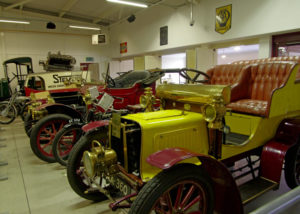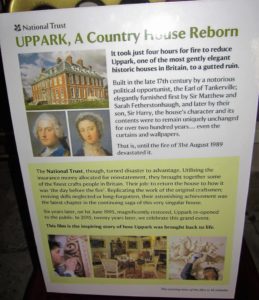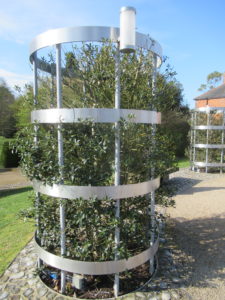Poised on the South Downs near South Harting, Uppark, originally built by the Earl of Tankerville, gives a spectacular view, looking far out over the Solent.
It is not far from where I live in Chichester, so am able to visit quite easily, especially if it’s a nice day and you feel like spending some time at a National trust property.
It was a mixture of sun and cloud as we parked the car in the 2 tiered, spacious parking area. They keep several bays nearer the exit marked for disabled parking. There are some nice wooded areas for picnics on your left as you walk down towards the house.
What does rather irritate me when walking down to the main entrance to the house (originally the rear), the alabaster columns on the portico are so dirty looking – so I asked why they couldn’t perhaps be cleaned up.
Apparently they have to leave it as it is because lichens are growing on there!
Before looking around the house we enjoyed a nice cup of tea and scone in the outside seating area – a short distance from the restaurant. Glad we did, as we had several visits from a bird, landing on the table and enjoying some scone crumbs.
The shop is well laid out with lots of enticing things to buy. I always think there is a nice selection of cards in NT shops – especially the fun, ‘bean’ cards!
We then spent quite a while in the house looking round and chatting to the volunteer staff who are always happy to help. Did find out one interesting thing when walking around. While in the room where the tapestries hung, another visitor, who had visited somewhere in Paris, was told that something was always put into a tapestry to indicate the time period of when it was made. You could well spend ages looking for the clue as they are usually so large and full of same many things – interesting though! The member of staff was delighted when she heard about it. (Good idea to while away the time if she was having a ‘quiet day).’
On our way out we were told that if visiting on the first Wednesday of the month, there was an opportunity to visit the upstairs of the house. On the way back through the garden, there was a small outdoors building where they showed the time of the fire and how restoration took place.
So, more to the history. After the Earl of Tankerville, the house passed to Matthew Fetherstonhaugh who made many improvements to the building. His son Harry, friend of the Prince Regent, entertained there and caused great shock through society when he married the dairymaid when over the age of 70. He left the entire estate to her when he died in 1846. In turn, she left it to her unmarried sister who lived to 1895. Provision was made for the estate to pass, after the life tenancy of a neighbour, to the second surviving son of another friend and neighbour, the fourth Earl of Clanwilliam on the condition he assumed the name of Fetherstonhaugh.
H.G. Wells’ mother Sarah was housekeeper at Uppark between 1850 – 1855, and he went to school and taught for a while, in Midhurst. Wells moved to London, but didn’t forget West Sussex, as shown in his work. The story of The Invisible Man starts off in Iping (in the Rother Valley near Midhurst), when a stranger walks into The Coach and Horses covered in bandages and lots of clothing – the Invisible Man in person.
On August Bank Holiday Monday in 1989 during opening hours, a fire started caused by a workman’s blowtorch while repairing lead flashing on the roof. When the alarm went off in the late afternoon, guests were ushered outside even though at that time, there was no sign of smoke. Builders, working on the roof repairs did see the blaze and tried to put it out with extinguishers, but it proved too much. The fire brigade arrived quickly but the fire was soon raging. 150 firefighters with 27 vehicles fought to tackle it ad the fire could be seen for many miles away.
Contents of the house were carried out by the Meade-Fetherstonhaugh family, staff and members of the public.
Following the fire, a decision had to be made whether to restore the house. The Trust could restore the historic house, or, build something completely different in its place. They took the traditional route and restored Uppark so effectively that it is difficult for the visitor to spot the differences. The fire galvanised the largest conservation exercise ever undertaken by the National Trust, calling in all its expertise and resources – people with skills from far and wide. West Dean provided many craftsmen and women, expertise, facilities and support.
Four tons of paper was generated when the case, hinging on insurance law, was taken right up to the House of Lords. The house, after the fire was 4 feet deep in ash and rubble. Gridded, like that of an archaeological site it recorded each cubic metre of ash as to where it came from, then stored in 4000 plastic dustbins – later reused for Windsor Castle. A riddling machine sifted out fragments to extract architectural detail. Making copies, meant that conservation was often cheaper than replacement. All this resulted in a magnificent achievement and the house re-opened in 1995.
When the fire at Windsor Castle broke out, these highly skilled restorers, who had been called together, were called upon once again.
New companies were formed arising from working at Uppark which goes to show how important it is to train the next generation of craftsmen and women.
Worth a visit to see for yourself, how this historic house was restored after such devastating destruction.










